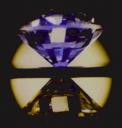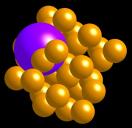EX-cubed: EXploring EXtremes EXperimentally
|
Diamond-Anvil Cell |
Ab-Initio Computations |
The High-Pressure Mineral Physics Lab at Yale is equipped with high-pressure devices which enable us to study the thermodynamic properties, pressure-induced phenomena, phase transitions and crystal structures of Earth and planetary materials at conditions relevant to the deep interior of the Earth or other planets.
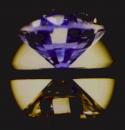 Diamond-anvil cells
Diamond-anvil cells
Diamond-anvil cells (DACs) generate very high pressure by applying force to two well-matched, gem-quality diamond anvils. The diamonds are fixed so that they are perfectly aligned and parallel with each other so that when brought together with screws (or a gas membrane), they remain aligned and hold pressure rather than breaking themselves. The small size of the culets (of order 100 micrometers), take advantage of the physical relation:pressure = force/area where the area is small.
Diamonds are strongest among known materials and is transparent to a wide range of electromagnetic radiation including, x-rays and visible. This allows us to measure in-situ x-ray diffraction or spectroscopy of samples at high pressure (to over ~1 Mbar) and temperature (up to a several 1000 K). Please see ourPublications page for our latest publications incorporating this technique.
Although there are several types of diamond cells available worldwide, only three variations are in use in this lab. One is made in Japan by Syntek and are symmetric-like in nature. The main difference between our cells and those of the first generation of symmetric cells (which we also have, made by the Princeton machine shop by George Rose), is our ability to adjust for anvil parallelism with a hemisphere vs. flat anvil seats. In one of our variations, we have slotted seat which allows for greater diffraction angle, however over a limited scattering area. As the DACs are “symmetric” either side may be used for collection or for introduction of electromagnetic beams (x-rays, laser, visible or infrared light).

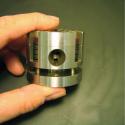
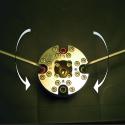
Above. Syntek DACs. Photo courtesy: Stefanie Japel
The left- and right-handed screws make applying the pressure on to the sample quite easy and steady. The belleville washers act as “springs” thereby allowing more turns to apply a given force (each have a spring constant) and thus a more precise way to apply pressure.
We also have two gas membrane DACs (mDACs) where the force is applied by gas made by EasyLab. These mDACs can be resistively heated to ~600 C and are currently used to measure the melting curve of potassium.
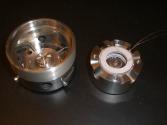
Above. EasyLab mDAC equipped with a ring heater.
We are also developing other ways to heat resistively, mainly using graphite and wire-wrapped anvil heaters.
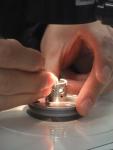

Left. Graduate student Zhixue Du wrapping a diamond anvil with a wire to make a resistance heater.Right. Blackbody radiation measured at ~1200 K for homemade ring heater as measured by our laser-heating spectrometer-based temperature measurement system.
Other DAC Facilities
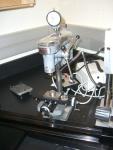
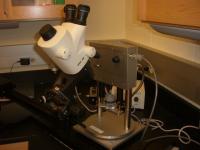 To facilitate sample preparation, we have both a micro-drill press and micro-EDM to make small holes in our gasket material with holes ranging in size from ~50 micrometers to ~300 micrometers (or larger) in diameter. A movable stereomicroscope on a boom is situated between the two for easy viewing of the gasket.
To facilitate sample preparation, we have both a micro-drill press and micro-EDM to make small holes in our gasket material with holes ranging in size from ~50 micrometers to ~300 micrometers (or larger) in diameter. A movable stereomicroscope on a boom is situated between the two for easy viewing of the gasket.
Our lab includes two stereomicroscopes, a glove box, fumehoods, a laser-cutting tool, a laser-heating system with both spectroradiometric and 4-color measurement systems, a cryogenic gas loading system, as well as numerous other pieces of equipment for DAC sample preparation and measurement.


Left. Leica S8 Apo stereomicroscope. Right. Vacuum oven, hot plate and microbalance.
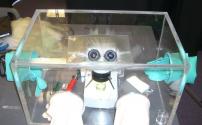
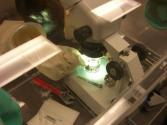
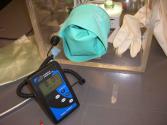
Above. Glove box equipped with stereomicroscope and oxygen meter for loading sensitive samples under an argon atmosphere.
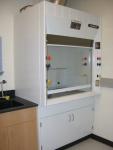
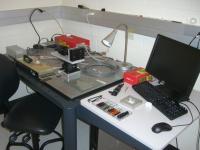
Left. The lab has two fumehoods for loading samples. Right. Computer-controlled pulsed near-IR laser-cutting tool used to cut gaskets, gasket pieces, both metal and ceramic.
Laser-Heating System
Our lab includes a 100W near-IR fiber laser that is split into two for double-sided laser heating of our high-pressure DAC samples to several 1000s of K. To measure temperature we use the inherent blackbody radiation of the glowing hot sample and a spectrometer to measure peak average temperatures. Additionally, we have built two 4-color T measurement systems that are able to map out the temperature distribution in the hot sample.



Left. Laser-heating setup. Center. Spectrometer and 4-color monitors. Right. One side of the 4-color temperature measurement system.
Raman Spectroscopy
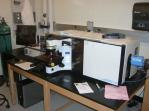 We also have a Horiba-Jobin Yvon HR-800 Raman Microscope equipped with a green laser tuned to 532 nm and three gratings: 1800, 1200 and 600. It is used for ruby fluorescence pressure measurement, and to measure the Raman spectra at both high pressure and at ambient pressure. It is equipped with confocal mapping abilities.
We also have a Horiba-Jobin Yvon HR-800 Raman Microscope equipped with a green laser tuned to 532 nm and three gratings: 1800, 1200 and 600. It is used for ruby fluorescence pressure measurement, and to measure the Raman spectra at both high pressure and at ambient pressure. It is equipped with confocal mapping abilities.
Raman spectroscopy is a powerful technique that complements both infrared spectroscopy and x-ray diffraction as it is sensitive to short-range ordering. It can be used to study volatiles and volatile-rich materials such as water and carbon dioxide.
Ab-initio Computations
Ab-initio computations are another powerful technique to simulate the extreme conditions of planetary interiors. In collaboration with Gerd Steinle-Neumann of the Bayerisches Geoinstitut, Boris Kiefer of NMSU and Bijaya Karki of Louisian State University, we combine our experimental results with those gained by theoretical means to better understand our results and what they mean for the Earth and other planteray interiors. Please see our Publications page for our latest publications incorporating this technique.
